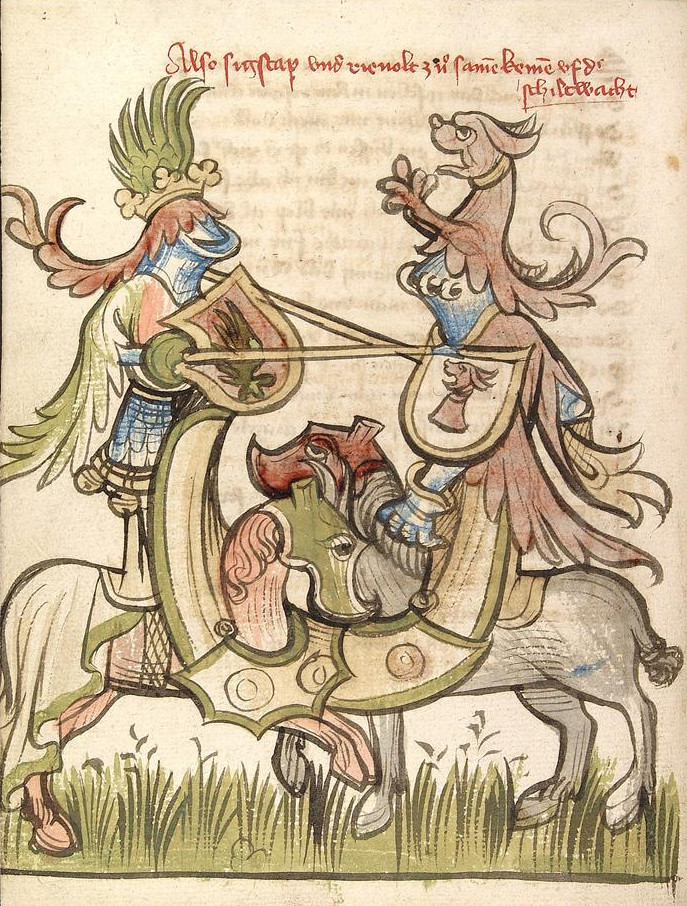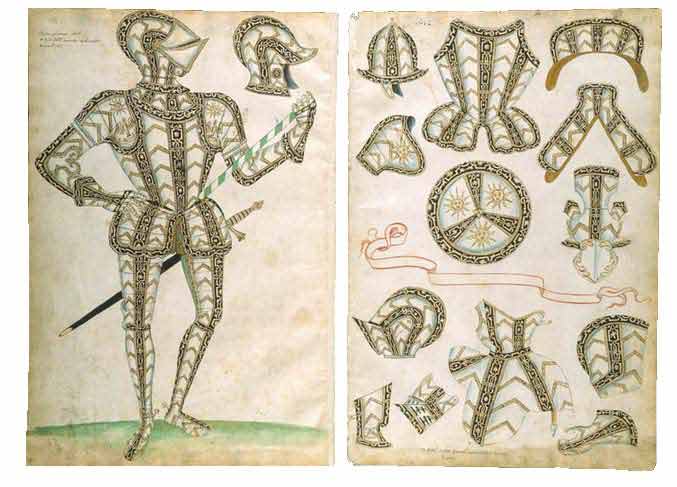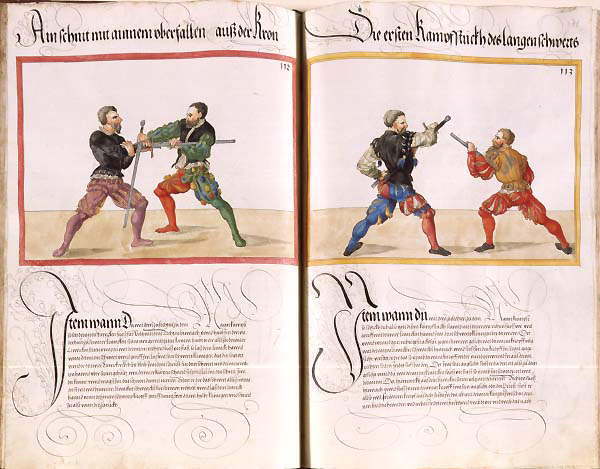|
Joust
Jousting is a martial game or hastilude between two horse riders wielding lances with blunted tips, often as part of a tournament. The primary aim was to replicate a clash of heavy cavalry, with each participant trying to strike the opponent while riding towards him at high speed, breaking the lance on the opponent's shield or jousting armour if possible, or unhorsing him. The joust became an iconic characteristic of the knight in Romantic medievalism. The participants experience close to three and a quarter times their body weight in G-forces when the lances collide with their armour. The term is derived from Old French , ultimately from Latin "to approach, to meet". The word was loaned into Middle English around 1300, when jousting was a very popular sport among the Anglo-Norman knighthood. The synonym tilt (as in tilting at windmills) dates . Jousting is based on the military use of the lance by heavy cavalry. It transformed into a specialized sport during the Late Middle ... [...More Info...] [...Related Items...] OR: [Wikipedia] [Google] [Baidu] |
Tournament (medieval)
A tournament, or tourney (from Old French ''torneiement'', ''tornei''), was a chivalry, chivalrous competition or Mock combat, mock fight in the Middle Ages and Renaissance (12th to 16th centuries), and is one type of hastilude. Tournaments included melee and hand-to-hand combat (weapons were often blunted to prevent serious injury), contests of strength or History of archery, accuracy, and sometimes Jousting, jousts. Some thought that the tournaments were a threat to public order. The shows were often held because of coronations, marriages of notable figures, births, recent conquests, peace treatises, etc. They were held to welcome of people of perceived high worth, ambassadors, lords, and so on. Finally, some tournaments were held simply for pure entertainment. Such tournaments were depicted throughout the ''Codex Manesse''. Etymology Old French was in use in the 12th century, from a verb , ultimately Latin "to turn". The same word also gave rise to the Italian (modern Eng ... [...More Info...] [...Related Items...] OR: [Wikipedia] [Google] [Baidu] |
Hastilude
Hastilude is a generic term used in the Middle Ages to refer to many kinds of martial games. The word comes from the Latin ''hastiludium'', literally "lance game". By the 14th century, the term usually excluded tournaments and was used to describe the other games collectively; this seems to have coincided with the increasing preference for ritualistic and individualistic games over the traditional mêlée style. Today, the most well-known of the hastiludes are the tournament, or ''tourney'', and the joust, but over the medieval period a number of other games and sports developed, which differed in popularity and rules from area to area, and from period to period. Distinction was made between the different types by contemporaries in their description, laws, prohibitions, and customs. Types of hastiludes Joust In contrast to the tournament, which comprised teams of large numbers ranging over large tracts of land, the joust was fought between two individuals on horseback, ... [...More Info...] [...Related Items...] OR: [Wikipedia] [Google] [Baidu] |
Hastilude
Hastilude is a generic term used in the Middle Ages to refer to many kinds of martial games. The word comes from the Latin ''hastiludium'', literally "lance game". By the 14th century, the term usually excluded tournaments and was used to describe the other games collectively; this seems to have coincided with the increasing preference for ritualistic and individualistic games over the traditional mêlée style. Today, the most well-known of the hastiludes are the tournament, or ''tourney'', and the joust, but over the medieval period a number of other games and sports developed, which differed in popularity and rules from area to area, and from period to period. Distinction was made between the different types by contemporaries in their description, laws, prohibitions, and customs. Types of hastiludes Joust In contrast to the tournament, which comprised teams of large numbers ranging over large tracts of land, the joust was fought between two individuals on horseback, ... [...More Info...] [...Related Items...] OR: [Wikipedia] [Google] [Baidu] |
Accession Day Tilt
The Accession Day tilts were a series of elaborate festivities held annually at the court of Elizabeth I of England to celebrate her Accession Day, 17 November, also known as Queen's Day. The tilts combined theatre, theatrical elements with jousting, in which Elizabeth's courtiers competed to outdo each other in allegory, allegorical armour and costume, poetry, and Medieval pageant, pageantry to exalt the queen and her realm of England.Strong 1977, p. 129-133 The last Elizabethan Accession Day tilt was held in November 1602; the queen died the following spring. Tilts continued as part of festivities marking the Accession Day of James I of England, James I, 24 March, until 1624, the year before his death. Origins Sir Henry Lee of Ditchley, Queen's Champion, devised the Accession Day tilts, which became the most important Elizabethan era, Elizabethan court festival from the 1580s. The celebrations are likely to have begun somewhat informally in the early 1570s. By 1581, ... [...More Info...] [...Related Items...] OR: [Wikipedia] [Google] [Baidu] |
Jousting Armour
Plate armour is a historical type of personal body armour made from bronze, iron, or steel plates, culminating in the iconic suit of armour entirely encasing the wearer. Full plate steel armour developed in Europe during the Late Middle Ages, especially in the context of the Hundred Years' War, from the coat of plates worn over mail suits during the 14th century. In Europe, plate armour reached its peak in the late 15th and early 16th centuries. The full suit of armour, also referred to as a panoply, is thus a feature of the very end of the Middle Ages and the Renaissance period. Its popular association with the " medieval knight” is due to the specialised jousting armour which developed in the 16th century. Full suits of Gothic plate armour were worn on the battlefields of the Burgundian and Italian Wars. The most heavily armoured troops of the period were heavy cavalry, such as the gendarmes and early cuirassiers, but the infantry troops of the Swiss mercenaries and the Lan ... [...More Info...] [...Related Items...] OR: [Wikipedia] [Google] [Baidu] |
Henry II Of France
Henry II (french: Henri II; 31 March 1519 – 10 July 1559) was King of France from 31 March 1547 until his death in 1559. The second son of Francis I and Duchess Claude of Brittany, he became Dauphin of France upon the death of his elder brother Francis in 1536. As a child, Henry and his elder brother spent over four years in captivity in Spain as hostages in exchange for their father. Henry pursued his father's policies in matters of art, war, and religion. He persevered in the Italian Wars against the Habsburgs and tried to suppress the Reformation, even as the Huguenot numbers were increasing drastically in France during his reign. Under the April 1559 Peace of Cateau-Cambrésis which ended the Italian Wars, France renounced its claims in Italy, but gained certain other territories, including the Pale of Calais and the Three Bishoprics. These acquisitions strengthened French borders while the abdication of Charles V, Holy Roman Emperor in January 1556 and division of h ... [...More Info...] [...Related Items...] OR: [Wikipedia] [Google] [Baidu] |
Tiltyard
A tiltyard (or tilt yard or tilt-yard) was an enclosed courtyard for jousting. Tiltyards were a common feature of Tudor era castles and palaces. The Horse Guards Parade in London was formerly the tiltyard constructed by Henry VIII as an entertainment venue adjacent to Whitehall Palace; it was the site of the Accession Day tilts in the reigns of Elizabeth I and James I. Henry VIII also constructed a tiltyard at Hampton Court Palace, where one of the towers, known as the Tiltyard Tower, was used for viewing the tournaments below. The Tiltyard at Whitehall was "a permanent structure and apparently had room for 10–12,000 spectators, accommodated in conditions which ranged from the spartan to the opulent." Ambitious young aristocrats participated in the Accession Day events for the Elizabeth I in 1595 where "the whole chivalric nature of the tournament with its mock combat and heroic connotations was peculiarly appealing." The aristocrats who attended wore elaborate costumes "desig ... [...More Info...] [...Related Items...] OR: [Wikipedia] [Google] [Baidu] |
Equestrian Sports
Equestrian sports are sports that use horses as a main part of the sport. This usually takes the form of the rider being on the horse's back, or the horses pulling some sort of horse-drawn vehicle. General * 4-H * Equitation *Horse show * Icelandic equitation * Jineteada gaucha *Mounted orienteering *Pleasure riding *Pony Club *Sidesaddle *Sinjska alka *Techniques de Randonnée Équestre de Compétition *Trail riding *Working equitation *Barrel Racing FEI International Disciplines *Combined driving *Dressage *Dzhigitovka *Endurance *Eventing *Para-equestrian *Reining *Show jumping Regional governance *Horseball *Tent pegging Olympic disciplines *Dressage *Eventing *Show jumping *Equestrian vaulting Paralympic disciplines *Dressage only at the Paralympics; dressage and combined driving at other FEI events Dressage *Doma menorquina *Doma vaquera Racing *Flat racing *Harness racing * Point-to-point * Steeplechase *Thoroughbred horse racing Other timed events *Gymkhana *Skijorin ... [...More Info...] [...Related Items...] OR: [Wikipedia] [Google] [Baidu] |
Paulus Hector Mair
Paulus Hector Mair (1517–1579) was a German civil servant fencing master from Augsburg. He collected Fechtbücher and undertook to compile all knowledge of the art of fencing in a compendium surpassing all earlier books. For this, he engaged the painter Jörg Breu the Younger, as well as two experienced fencers, whom he charged with perfecting the techniques before they were painted. The project was very costly, taking a full four years, and according to Mair, consumed most of his family's income and property. Three versions of his compilation, and one later, less extensive manuscript, have been preserved. Not only did Mair spend huge sums on his collections and on his projects, he also had a very expensive lifestyle, frequently hosting receptions for the more important burghers of Augsburg. His own income was not sufficient for this, and during many years, he misappropriated funds from the city treasury, with the supervision of which he had been entrusted since 1541. His embezz ... [...More Info...] [...Related Items...] OR: [Wikipedia] [Google] [Baidu] |
Heavy Cavalry
Heavy cavalry was a class of cavalry intended to deliver a battlefield charge and also to act as a Military reserve, tactical reserve; they are also often termed ''shock cavalry''. Although their equipment differed greatly depending on the region and historical period, heavy cavalry were generally mounted on large powerful warhorses, wore body armor, and armed with either lances, swords, Mace (bludgeon), maces, flail (weapon), flails (disputed), battle axes, or war hammers; their mounts may also have been protected by barding. They were distinct from light cavalry, who were intended for Reconnaissance, scouting, Screening (tactical), screening, and skirmishing. History of heavy cavalry Persians Iranian tribes such as the Massagetae were believed to be the originator of the class of heavy cavalry known as cataphract. During the time of Achaemenid Empire, Achaemenid Persia cavalry was the elite arm of service (as was the case in most civilizations), and many Persian ho ... [...More Info...] [...Related Items...] OR: [Wikipedia] [Google] [Baidu] |
Nobility
Nobility is a social class found in many societies that have an aristocracy (class), aristocracy. It is normally ranked immediately below Royal family, royalty. Nobility has often been an Estates of the realm, estate of the realm with many exclusive functions and characteristics. The characteristics associated with nobility may constitute substantial advantages over or relative to non-nobles or simply formal functions (e.g., Order of precedence, precedence), and vary by country and by era. Membership in the nobility, including rights and responsibilities, is typically Hereditary title, hereditary and Patrilinearity, patrilineal. Membership in the nobility has historically been granted by a monarch or government, and acquisition of sufficient power, wealth, ownerships, or royal favour has occasionally enabled commoners to ascend into the nobility. There are often a variety of ranks within the noble class. Legal recognition of nobility has been much more common in monarchies, ... [...More Info...] [...Related Items...] OR: [Wikipedia] [Google] [Baidu] |
James VI And I
James VI and I (James Charles Stuart; 19 June 1566 – 27 March 1625) was King of Scotland as James VI from 24 July 1567 and King of England and Ireland as James I from the union of the Scottish and English crowns on 24 March 1603 until his death in 1625. The kingdoms of Scotland and England were individual sovereign states, with their own parliaments, judiciaries, and laws, though both were ruled by James in personal union. James was the son of Mary, Queen of Scots, and a great-great-grandson of Henry VII, King of England and Lord of Ireland, and thus a potential successor to all three thrones. He succeeded to the Scottish throne at the age of thirteen months, after his mother was compelled to abdicate in his favour. Four different regents governed during his minority, which ended officially in 1578, though he did not gain full control of his government until 1583. In 1603, he succeeded Elizabeth I, the last Tudor monarch of England and Ireland, who died childless. He ... [...More Info...] [...Related Items...] OR: [Wikipedia] [Google] [Baidu] |

_von_Anhalt.jpg)









